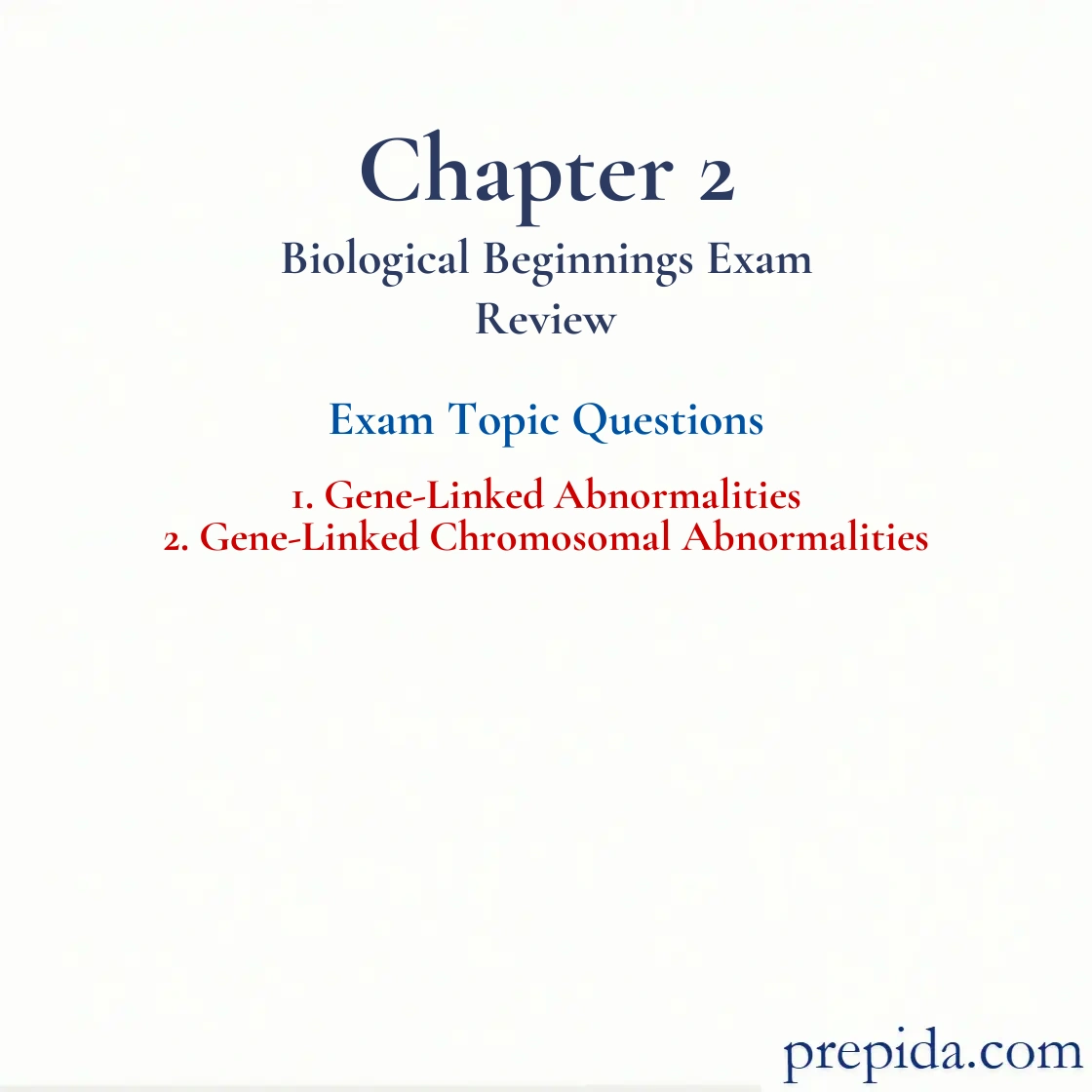
Phenylketonuria (PKU) is a genetic disorder in which an individual cannot properly metabolize ________, an amino acid.
- phenylamine
- phenylalanine
- phenylacetylene
- phenylacetamide
Phenylketonuria (PKU): A genetic disorder in which an individual cannot properly metabolize an amino acid called phenylalanine. PKU is now easily detected but, if left untreated, results in intellectual disability and hyperactivity.
Brianna goes to a doctor who specializes in identifying genetic flaws to help prevent the risk of abnormalities. This doctor is called
- a genealogist.
- a genetic counselor.
- a chromosomal advisor.
- a physiologist.
Joshua, a two-year-old, has been diagnosed with ________, a blood disorder that limits the body's oxygen supply and can cause joint swelling and heart and kidney failure. This genetic disorder can be treated through penicillin, pain medication, antibiotics, blood transfusions, and hydroxyurea.
- spina bifida
- Tay-Sachs disease
- sickle-cell anemia
- Huntington's disease
Sickle-Cell Anemia: A genetic disorder that affects the red blood cells and occurs most often in people of African descent.
Mateo, an infant, is on a special diet as his parents are aware that he has a genetic disorder in which he cannot metabolize phenylalanine, an amino acid. Mateo's parents are also aware of the importance of this diet and that excess phenylalanine buildup in the infant will produce intellectual disability and hyperactivity. This genetic disorder results from a
- dominant gene.
- recessive gene.
- complementary gene.
- longevity gene.
Intellectual Disability: A condition of limited mental ability in which the individual (1) has a low IQ, usually below 70 on a traditional intelligence test, (2) has difficulty adapting to the demands of everyday life, and (3) first exhibits these characteristics by age 18.
Which of the following is a gene-linked abnormality?
- Down syndrome
- Phenylketonuria (PKU)
- Turner syndrome
- Klinefelter syndrome
Phenylketonuria (PKU): A genetic disorder in which an individual cannot properly metabolize an amino acid called phenylalanine. PKU is now easily detected but, if left untreated, results in intellectual disability and hyperactivity.
Tamara, an African American, is born with a genetic disorder that causes her body's red blood cells to become hook shaped instead of being disk shaped, impairing the normal oxygen-carrying capacity of the cells. The doctors explain to Tamara's parents that this condition, however, makes her resistant to malaria. Which of the following disorders is Tamara most likely suffering from?
- Tay-Sachs disease
- Sickle-cell anemia
- Leukemia
- Huntington's disease
Sickle-Cell Anemia: A genetic disorder that affects the red blood cells and occurs most often in people of African descent.
________ is a genetic abnormality in which delayed blood clotting causes internal and external bleeding.
- Hemophilia
- Phenylketonuria
- Sickle-cell anemia
- Tay-Sachs disease
Paul has a gene-linked abnormality, and as a result he suffers from an X-linked inheritance disease. Because of this disease, Paul suffers from internal and external bleeding due to delayed blood clotting. Which of the following will effectively treat Paul's condition?
- Hydroxyurea
- Blood transfusions
- Anticoagulants
- Blood irradiation therapy
Samantha is diagnosed with a genetic disorder. She suffers from glandular dysfunction that hinders mucus production. She has difficulty in breathing, and her digestion is hampered. She also has frequent lung infections and suffers from shortness of breath. In this scenario, which of the following genetic disorders is Samantha most likely suffering from?
- Cystic fibrosis
- Huntington's disease
- Phenylketonuria
- Tay-Sachs disease
Benny has been diagnosed with a gene-linked abnormality characterized by deceleration of mental and physical development caused by an accumulation of lipids in the nervous system. He has been put on medication and a special diet, but his family has been told that he will probably not live beyond the age of five. Benny is suffering from
- spina bifida.
- Tay-Sachs disease.
- phenylketonuria.
- Huntington's disease.
Which of the following would be an appropriate course of treatment for a person diagnosed with cystic fibrosis?
- Medication for pain, antibiotics, blood transfusions, and hydroxyurea
- Insulin treatment
- Blood transfusions/injection
- Physical and oxygen therapy, synthetic enzymes, and antibiotics
Mary and Jim are expecting a child. During prenatal diagnostic testing, the doctor confirms that the fetus has a genetic abnormality that will lead to a neural tube disorder causing brain and spine abnormalities. He also tells the parents that the baby will most likely have protruding tissue, especially from the lower back, and that the abnormality can be treated with corrective surgery at birth, orthopedic devices, and physical or medical therapy. Which of the following disorders is Mary and Jim's child suffering from?
- Spina bifida
- Tay-Sachs disease
- Phenylketonuria
- Huntington's disease
Lindsay's body does not produce enough insulin, causing abnormal metabolism of sugar. She is receiving insulin treatment. Lindsay has
- spina bifida.
- hemophilia.
- phenylketonuria.
- diabetes.
Which of the following is true of phenylketonuria?
- It results from a recessive gene.
- It is a chromosomal disorder.
- It results in death by the age of five.
- It is caused by an accumulation of lipids in the nervous system.
Phenylketonuria (PKU): A genetic disorder in which an individual cannot properly metabolize an amino acid called phenylalanine. PKU is now easily detected but, if left untreated, results in intellectual disability and hyperactivity.
________ is a gene-linked abnormality in which the central nervous system deteriorates, producing problems in muscle coordination and mental deterioration.
- Cystic fibrosis
- Phenylketonuria
- Huntington's disease
- Tay-Sachs disease
Parkinson Disease: A chronic, progressive disease characterized by muscle tremors, slowing of movement, and partial facial paralysis.